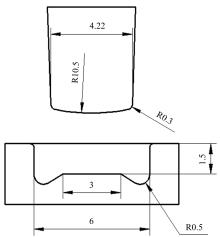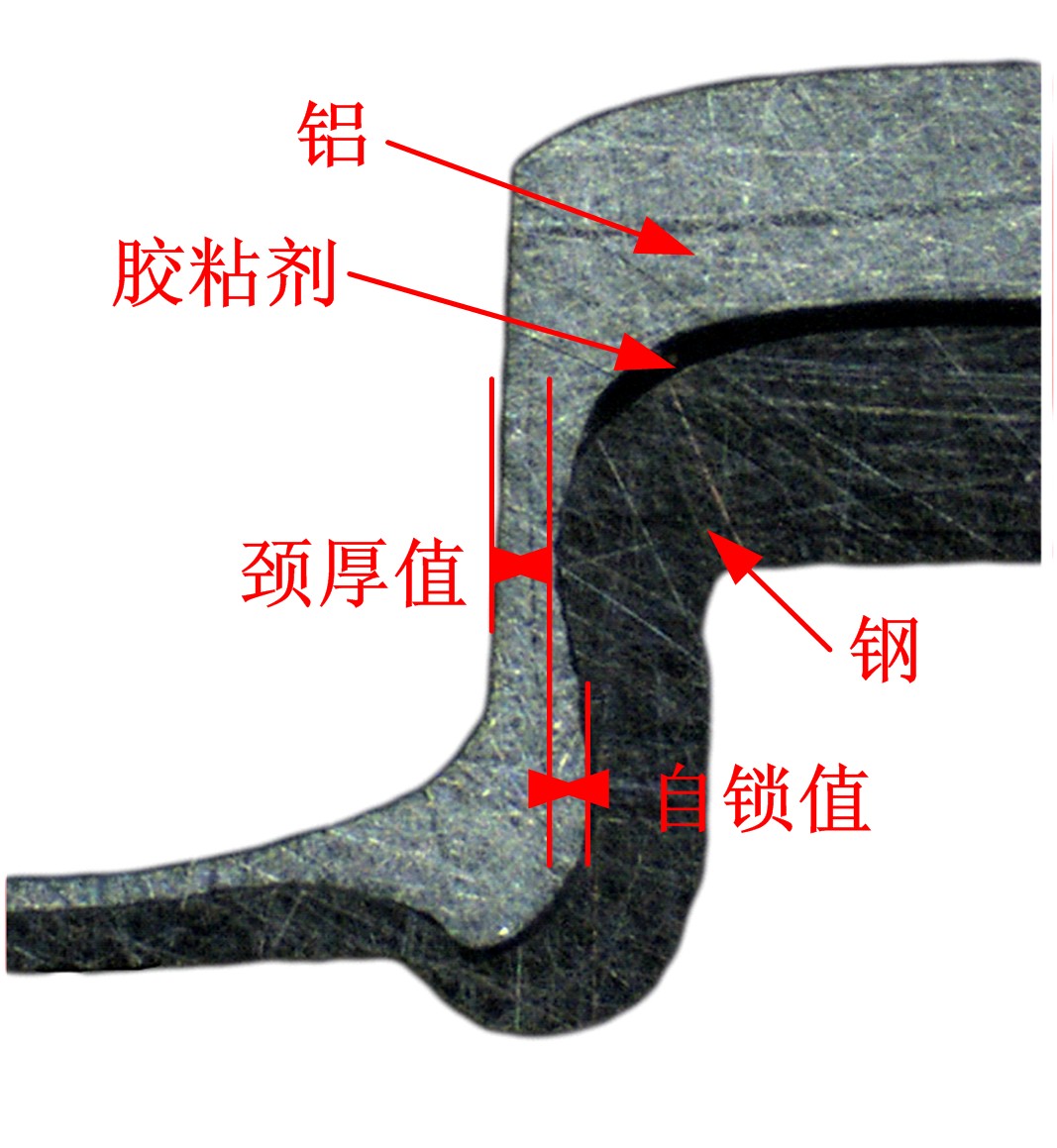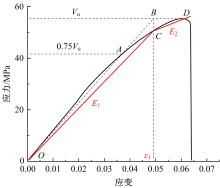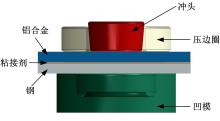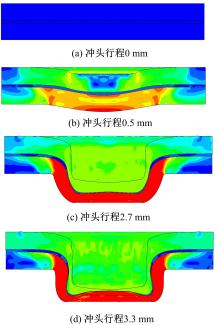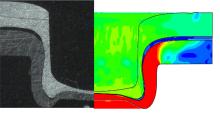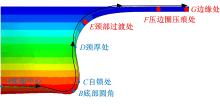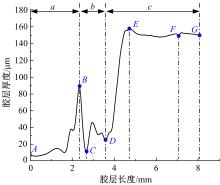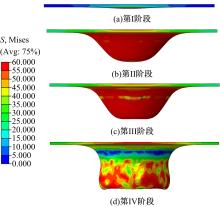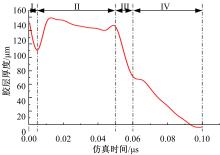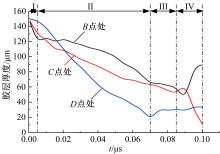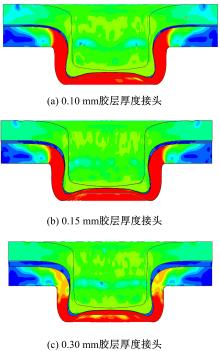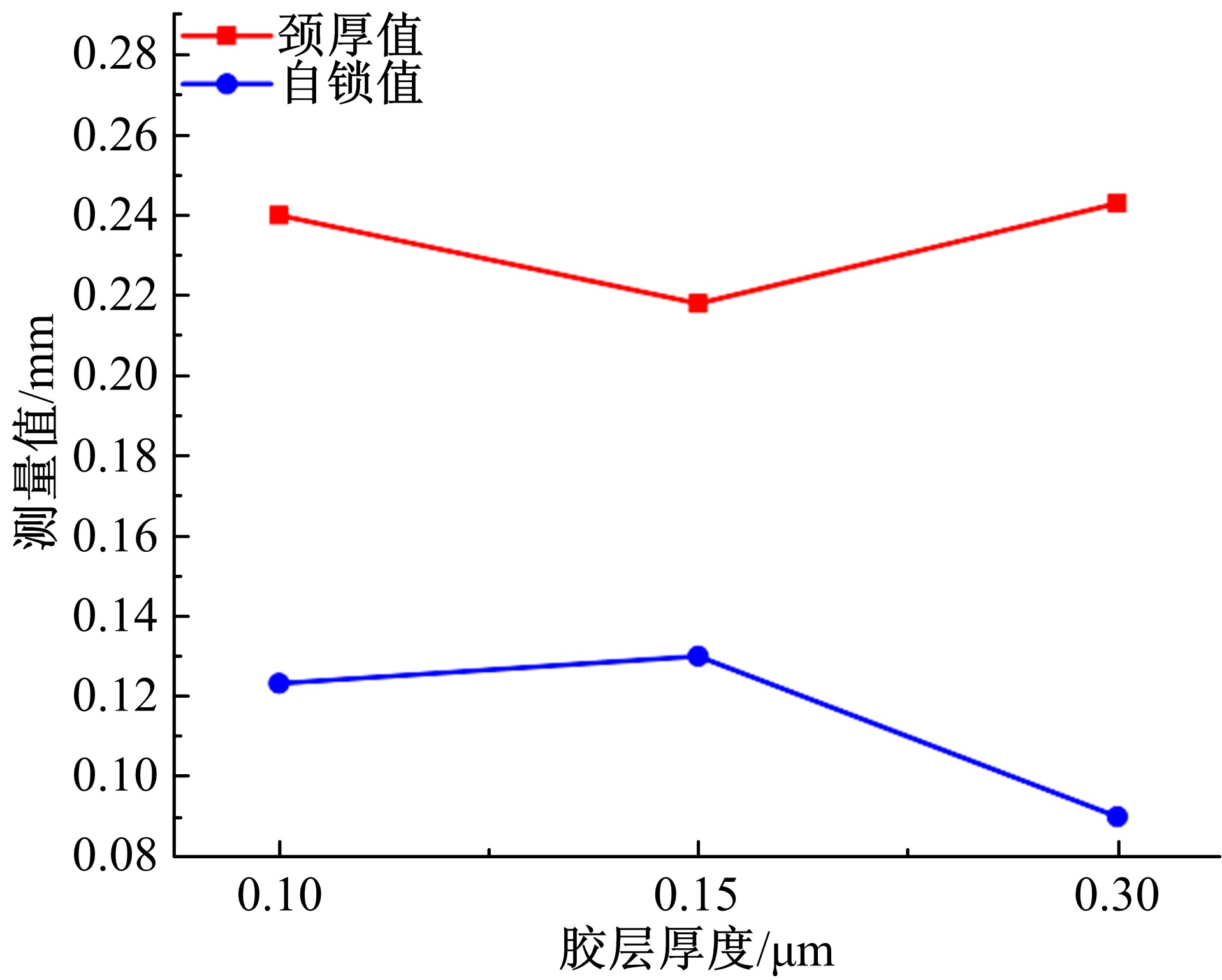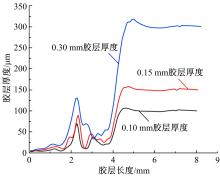Journal of Jilin University(Engineering and Technology Edition) ›› 2020, Vol. 50 ›› Issue (1): 100-106.doi: 10.13229/j.cnki.jdxbgxb20181206
Thickness distribution of adhesive layer in dissimilar clinch⁃adhesive hybrid joint with steel and aluminum alloy
Wei-min ZHUANG1( ),Hong-da SHI1,Dong-xuan XIE2,Guan-nan YANG3
),Hong-da SHI1,Dong-xuan XIE2,Guan-nan YANG3
- 1. State Key Laboratory of Automotive Simulation and Control, Jilin University, Changchun 130022, China
2. Department of Technical Development, FAW?Volkswagen Automobile Co. Ltd. , Changchun 130011, China
3. Safety Technology Development Division, Geely Automobile Research Institute(Ningbo), Ningbo 315336, China
CLC Number:
- TG146
| 1 | Sadowski T, Balawender T, Golewski P. Technological Aspects of Manufacturing and Numerical Modelling of Clinch-Adhesive Joints[M]. Berlin: Springer International Publishing, 2015. |
| 2 | Gómez S, Oñoro J, Pecharromán J. A simple mechanical model of a structural hybrid adhesive/riveted single lap joint[J]. International Journal of Adhesion & Adhesives, 2007, 27(4):263-267. |
| 3 | Balawender T, Sadowski T, Golewski P. Numerical analysis and experiments of the clinch-bonded joint subjected to uniaxial tension[J]. Computational Materials Science, 2012, 64:270-272. |
| 4 | Sadowski T, Kneć M, Golewski P. Experimental investigations and numerical modelling of steel adhesive joints reinforced by rivets[J]. International Journal of Adhesion & Adhesives, 2010, 30(5):338-346. |
| 5 | He X, Zhao L, Yang H, et al. Investigations of strength and energy absorption of clinched joints[J]. Computational Materials Science, 2014, 94(11):58-65. |
| 6 | 陈吉清, 邱泽鑫, 周云郊,等. 钢铝板材压-胶复合连接性能[J]. 哈尔滨工业大学学报, 2016, 48(7):169-175. |
| Chen Ji-qing, Qiu Ze-xin, Zhou Yun-jiao,et al. Performances of clinch-bonded hybrid joints between steel-aluminum sheets[J]. Journal of Harbin Institute of Technology, 2016, 48(7):169-175. | |
| 7 | 李龙, 胡平, 刘立忠. 不同胶层厚度单搭接接头剪切试验与强度预测[J]. 农业机械学报, 2010, 41(12):17-21. |
| Li Long, Hu Ping, Liu Li-zhong. Strength of adhesively bonded single lap for differential bondline thickness and tension loading prediction[J]. Transactions of the Chinese Society for Agricultural Machinery, 2010, 41(12):17-21. | |
| 8 | 杨辛. 胶焊接头在碰撞载荷下失效的模拟方法研究及其应用[D]. 北京:清华大学机械学院, 2010. |
| Yang Xin. Research and application of the simula- tion method for failure of adhesive welded joint under impact load[D]. Beijing: College of Mechanical Engineering, Tsinghua University, 2010. | |
| 9 | 庄蔚敏, 赵文增, 解东旋,等. 超高强钢/铝合金热铆连接接头性能[J]. 吉林大学学报:工学版, 2018,48(4): 1016-1022. |
| Zhuang Wei-min, Zhao Wen-zeng, Xie Dong-xuan, et al. Joint performance analysis on connection of ultrahigh-strength steel and aluminum alloy with hot riveting[J]. Journal of Jilin University(Engineering and Technology Edition), 2018,48(4): 1016-1022. | |
| 10 | Na Jing-xin, Mu Wen-long, Qin Guo-feng, et al. Effect of temperature on the mechanical properties of adhesively bonded basalt FRP-aluminum alloy joints in the automotive industry[J]. International Journal of Adhesion & Adhesives, 2018,85:138-148. |
| [1] | Qing-feng GUAN,Xin-wen YAO,Yang YANG,Ling-yan ZHANG,Di LIU,Chen LI,Peng LYU. Preparation and property of Cr alloying layer on TC4 after surface alloying induced by high current pulsed electron beam [J]. Journal of Jilin University(Engineering and Technology Edition), 2019, 49(6): 2002-2009. |
| [2] | Zhou SHI,Shu-qing KOU. Performance analysis and lightweight design of 36MnVS4 fracture⁃splitting connecting rod [J]. Journal of Jilin University(Engineering and Technology Edition), 2019, 49(6): 1992-2001. |
| [3] | Xin LI,Yan-peng SUN,Dan WANG,Jun-xu CHEN,Zheng-wei GU,Hong XU. Finite element numerical simulation for automobile front floor forming [J]. Journal of Jilin University(Engineering and Technology Edition), 2019, 49(5): 1608-1614. |
| [4] | Wen⁃quan LIU,Liang YING,Hai RONG,Ping HU. Forming limit prediction of high strength steel based on damage modified M⁃K model [J]. Journal of Jilin University(Engineering and Technology Edition), 2019, 49(4): 1266-1271. |
| [5] | Xin LI,Dan WANG,Jun⁃xu CHEN,Yan⁃peng SUN,Zheng⁃wei GU,Hong XU. Numerical simulation for handbrake fixed plate forming [J]. Journal of Jilin University(Engineering and Technology Edition), 2019, 49(4): 1258-1265. |
| [6] | JIANG Qiu-yue,YANG Hai-feng,TAN Cai-wang. Strengthening properties of welded joints of 22MnB5 super high strength steel [J]. Journal of Jilin University(Engineering and Technology Edition), 2018, 48(6): 1806-1810. |
| [7] | HU Zhi-qing, YAN Ting-xu, LI Hong-jie, LYU Zhen-hua, LIAO Wei, LIU Geng. Effect of cryogenic treatment on punch-shearing performance of aluminum alloy sheet [J]. Journal of Jilin University(Engineering and Technology Edition), 2018, 48(5): 1524-1530. |
| [8] | QIU Xiao-ming, WANG Yin-xue, YAO Han-wei, FANG Xue-qing, XING Fei. Multi-objective optimization of resistance spot welding parameters for DP1180/DP590 using grey relational analysis based Taguchi [J]. 吉林大学学报(工学版), 2018, 48(4): 1147-1152. |
| [9] | CHEN Jun-fu, GUAN Zhi-ping, YANG Chang-hai, NIU Xiao-ling, JIANG Zhen-tao, Song Yu-quan. Comparison of strain ranges and mechanical properties of metal rods under tension and torsion tests [J]. 吉林大学学报(工学版), 2018, 48(4): 1153-1160. |
| [10] | LIANG Xiao-bo, CAI Zhong-yi, GAO Peng-fei. Numerical simulation and experiment of cylindrical forming of sandwich composite panel [J]. 吉林大学学报(工学版), 2018, 48(3): 828-834. |
| [11] | LIU Zi-wu, LI Jian-feng. Erosion damage and evaluation of remanufacturing cladding layer for impeller metals FV520B [J]. 吉林大学学报(工学版), 2018, 48(3): 835-844. |
| [12] | LIU Chun-guo, LIU Wei-dong, DENG Yu-shan. Effect of multi-point punch active loading path on the stretch-forming of sheet [J]. 吉林大学学报(工学版), 2018, 48(1): 221-228. |
| [13] | XING Hai-yan, GE Hua, LI Si-qi, YANG Wen-guang, SUN Xiao-jun. Hidden defect metal magnetic memory identification for welded joints based on fuzzy membership and maximum likelihood estimation [J]. 吉林大学学报(工学版), 2017, 47(6): 1854-1860. |
| [14] | LYU Meng-meng, GU Zheng-wei, XU Hong, LI Xin. Process optimization of hot stamping for anti-collision beam with ultra high strength [J]. 吉林大学学报(工学版), 2017, 47(6): 1834-1841. |
| [15] | GU Xiao-yan, LIU Ya-jun, SUN Da-qian, XU Feng, MENG Ling-shan, GAO Shuai. Microstructures and mechanical properties of transient liquid phase diffusion bonded S355 steel/6005A aluminum alloy joint [J]. 吉林大学学报(工学版), 2017, 47(5): 1534-1541. |
|
||


